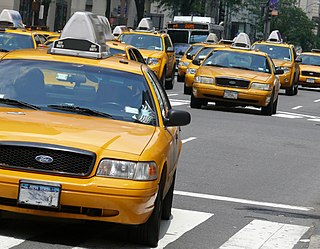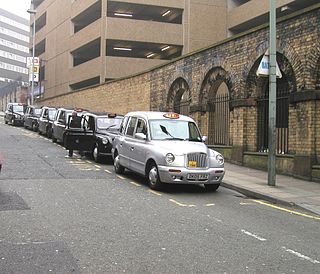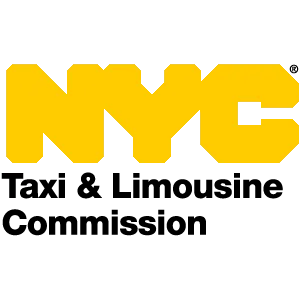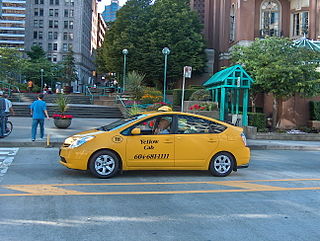

Before the start of local car production, the Mercedes-Benz 200, Mazda 323/Ford Laser, Toyota Mark II X80 series and the Opel Kadett were used. Most were scrapped and replaced by Protons, but there are still a large number running the roads. Those old models have a "Kereta Sewa" sign on top and use old taxi registration plates. [1]
Although most taxicabs run on diesel, a handful of taxicabs run on CNG.
There are a number of small taxicab companies and some private individual ones. Cabs are generally in red and white. Larger and reliable taxi companies are required to display they owned colors i.e. Sunlight Radio Cab, Innovasi Timur Orange Taxi Cab and Public Cab.
The reputation of Malaysia's taxi service has been marred by the poor conduct of local taxi drivers, who have been known, among others, refusing usage of taximeters, overcharging and force picking which destinations the customers will travel to, while also driving poorly maintained vehicles. Larger metered taxi companies i.e. Sunlight Radio Cab, RB Premier Taxi Sdn. Bhd., Uptownace (M) Sdn. Bhd., Laluan Emas Sdn. Bhd,. Insan Lemak Sdn. Bhd. and Innovasi Timur Orange Taxi Cab are more likely to charge passengers using meter; although they are still owned and managed by individual taxi drivers. Newer companies such as Swift Limousine & Cab owns and controls their vehicles with ensures all drivers have rigorous background checks. An alternative option is to use secure taxi booking apps like Grab or TaxiMonger. Drivers are certified safe and all will use taxi-meters. The apps also allow customers to contact the assigned driver directly and track their whereabouts on a real time map. [2] In a June 2008 survey conducted by Malaysian expatriate magazine The Expat on an estimated 200 foreigners from 30 countries, Malaysia's taxis were found to rank the lowest among the 23 countries in terms of quality, courtesy, availability and expertise. [2] [3] The behavior of taxi drivers has tarnished the image of Malaysia, particularly among foreign tourists, to the point some have begun resorting to paying for upscale taxis that are more expensive but operate with better service. [2]

A taxicab stand is a queue area on a street or on private property where taxicabs line up to wait for passengers.

Yellow cab taxicab operators exist all around the world. The original Yellow Cab Company, based in Chicago, Illinois, was one of the largest taxicab companies in the United States.

Checker Motors Corporation was a Kalamazoo, Michigan, vehicle manufacturer and tier-one subcontractor that manufactured taxicabs used by Checker Taxi. Morris Markin established the company in 1922, initially named the Checker Cab Manufacturing Company, in Chicago through a merger of Commonwealth Motors and Markin Automobile Body. The manufacturer moved to Kalamazoo in 1923 and was renamed to Checker Motors in 1958.

The Yellow Cab Company was a taxicab company in Chicago which was founded in 1907 by John D. Hertz.

In New York City, taxicabs come in two varieties: yellow and green; they are widely recognizable symbols of the city. Taxis painted yellow are able to pick up passengers anywhere in the five boroughs. Those painted apple green, which began to appear in August 2013, are allowed to pick up passengers in Upper Manhattan, the Bronx, Brooklyn, Queens, and Staten Island. Both types have the same fare structure. Taxicabs are operated by private companies and licensed by the New York City Taxi and Limousine Commission (TLC). It also oversees over 40,000 other for-hire vehicles, including "black cars", commuter vans, and ambulettes.

Taxis of Singapore come in two main varieties. Traditional taxi companies offer flag down and call bookings and their drivers are hired employees of the company. Ridesharing companies allow bookings through a smartphone, allowing ease for passengers, these are mostly known as private hire vehicles (PHV). Their apps also allow the flexibility to work and pick up passengers with their own vehicle, be it owned or rented, provided the various requirements are met depending on the company.

A motorcycle taxi, or cart bike or bike taxi, is a licensed form of transport in some countries. The taxi typically carries one passenger, who "rides pillion" behind the motorcycle operator. Multiple passengers are common in some countries.
Taxicabs in a single country often share a set of common properties, but there is a wide variation from country to country in the vehicles used, the circumstances under which they may be hired and the regulatory regime to which these are subject.
The taxicabs of the United States make up a mature system; most U.S. cities have a licensing scheme which restricts the number of taxicabs allowed. As of 2012 the total number of taxi cab drivers in the United States is 233,900; the average annual salary of a taxi cab driver is $22,820 and the expected percent job increase over the next 10 years is 16%.

Taxicabs are regulated throughout the United Kingdom, but the regulation of taxicabs in London is especially rigorous with regard to mechanical integrity and driver knowledge. An official report observed that: "Little however is known about the regulation by anyone outside the trade. The Public Carriage Office (PCO), which regulates and licenses taxis and private hire was transferred from the Metropolitan Police to become part of Transport for London in 2000." In 2015, there were around 298,000 licensed drivers in England, of which 164,000 were private hire licences, 62,000 were taxi licences and 72,000 were dual licences.

Cahya Mata Sarawak Berhad (CMSB) (MYX: 2852) is a leading corporation listed on the Main Market of the Malaysian stock exchange, Bursa Malaysia, and is a major private-sector player in Sarawak, the largest state in Malaysia.
Rapid Rail Sdn Bhd is the operator of the rapid transit (metro) system serving Kuala Lumpur and the Klang Valley area in Malaysia. A subsidiary of Prasarana Malaysia, it is the sole operator of five rapid transit lines which collectively form the Rapid KL rapid transit system. The system currently consists of three light rapid transit (LRT) lines, two mass rapid transit (MRT) lines and a monorail line, with another MRT and LRT line currently under construction.

The New York City Taxi and Limousine Commission is an agency of the New York City government that licenses and regulates the medallion taxis and for-hire vehicle industries, including app-based companies such as Uber and Lyft. The TLC's regulatory landscape includes medallion (yellow) taxicabs, green or Boro taxicabs, black cars, community-based livery cars, commuter vans, paratransit vehicles (ambulettes), and some luxury limousines.

Malaysia Airports Holdings Berhad is a Malaysian airport company that manages most of the airports in Malaysia. The firm was recently awarded the duty to manage airports in international destinations. It has its head office in the Malaysia Airports Corporate Office in the Persiaran Korporat KLIA in Kuala Lumpur International Airport (KLIA), Sepang, Selangor.
Illegal taxicabs, sometimes known as pirate taxis, gypsy cabs, or jitney cabs, are taxicabs and other for-hire vehicles that are not duly licensed or permitted by the jurisdiction in which they operate. Most major cities worldwide require taxicabs to be licensed, safety-inspected, insured as for-hire vehicles and use taximeters and there may also be requirements that the taxi driver be registered or accredited. However, many unlicensed cabs are in operation. Illegal cabs may be marked taxi vehicles, and others are personal vehicles used by an individual to offer unauthorized taxi-like services. Illegal cabs are prevalent in cities with medallion systems, which restrict the number of legal cabs in operation. Since their introduction in 2009, vehicles affiliated with the transportation network company Uber have been classified as illegal taxicabs in some jurisdictions.

A taxi, also known as a taxicab or simply a cab, is a type of vehicle for hire with a driver, used by a single passenger or small group of passengers, often for a non-shared ride. A taxicab conveys passengers between locations of their choice. This differs from public transport where the pick-up and drop-off locations are decided by the service provider, not by the customers, although demand responsive transport and share taxis provide a hybrid bus/taxi mode.

Cars such as Toyota Etios, Maruti Omni, Mahindra Logan, Tata Indica and Tata Indigo are fairly popular among taxicab operators. The livery of the taxicabs in India varies from state to state. In Delhi and Maharashtra, most taxicabs have yellow-black livery, while in West Bengal, taxis have yellow livery. Private taxicab operators are not required to have a specific livery. However, they are required by law to be registered as commercial vehicles.

Hybrid taxi or hybrid electric taxi is a taxicab service provided with a hybrid electric car (HEV), which combines a conventional internal combustion engine propulsion system with an electric propulsion system.
Taxi livery varies greatly from country to country. In some countries, livery is determined by Government legislation, in other countries, taxi operators have choice on colours.
Taxis in Vietnam are part of a complex transportation and economic system within the country. Taxicabs are one facet of a diverse 'vehicle for hire' ecosystem in Vietnam.